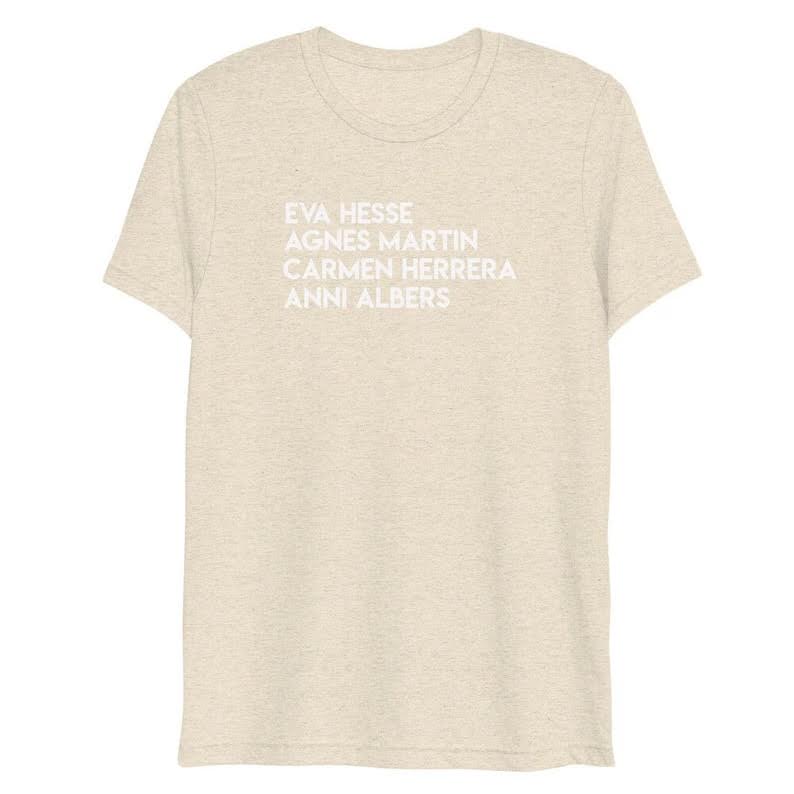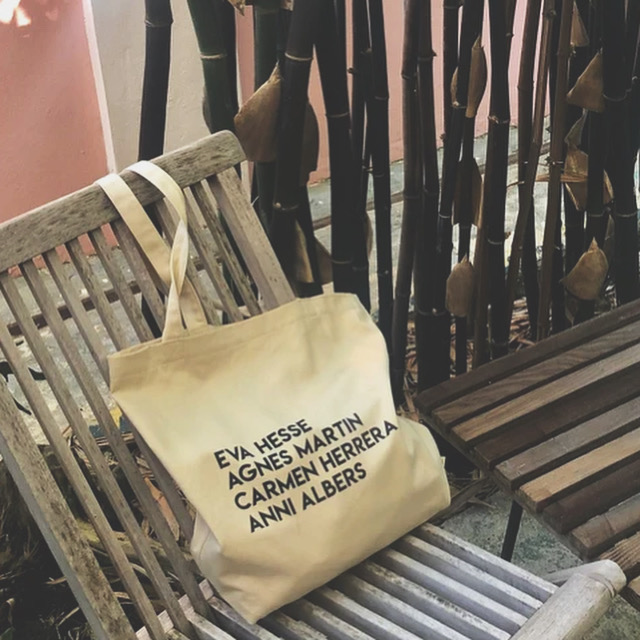We caught up with the brilliant and insightful VAU Studio a few weeks ago and have shared our conversation below.
VAU, thanks for taking the time to share your stories with us today Can you tell us a bit about who your hero is and the influence they’ve had on you?
I greatly admire a collective of visionary women artists whose courage, innovation, and persistence have profoundly shaped my understanding of creativity and purpose. Eva Hesse, Carmen Herrera, Agnes Martin, and Anni Albers each forged their own radical paths in the visual arts—often against the grain of a male-dominated art world that was not built to recognize or support their contributions. Their lives and work have become guiding lights for me, offering not only inspiration but a deep sense of kinship and possibility as a woman navigating my own creative journey.
Eva Hesse redefined sculpture with her use of unconventional materials like latex, fiberglass, and rope, creating works that embraced impermanence, process, and vulnerability. Her art was raw and intensely personal, full of contradictions—rigid yet soft, structured yet collapsing. At a time when conceptual minimalism was dominated by men, Hesse’s voice stood out for its emotional depth and bodily presence. Even as she faced a terminal illness, she continued to make work with urgency and conviction. From her, I’ve learned that there is strength in imperfection and bravery in making work that feels intimate and unresolved.
Carmen Herrera’s story has taught me about patience and unwavering dedication. A Cuban-born painter, she developed her distinctive hard-edge abstraction in the 1940s and yet was largely unrecognized until she was nearly 100 years old. Her work—precise, vibrant, and distilled to its purest form—was ahead of its time. Despite decades of invisibility in the art world, she never stopped painting. Herrera’s quiet persistence, her refusal to bend to trends or expectation, reminds me that the value of art lies not in immediate recognition, but in the truth of the artist’s vision. In 1998, when she was 83 years old, she got her first major museum show at El Museo del Barrio in NYC. It was not until 2004, however, that Herrera sold her first painting, at age 89. In 2015, on the occasion of the artist’s 100th birthday, a documentary about Herrera, titled The 100 Years Show, was released. One year later, the Whitney Museum in NYC staged “Lines of Sight,” an acclaimed exhibition of the artist’s works from 1948 to 1978. Herrera was still working when she passed at the age of 107 years old in 2022.
Agnes Martin, known for her serene grids and subtle mark-making, approached painting as a spiritual practice. Her work feels like meditation in visual form—calm, disciplined, and deeply intuitive. Martin’s choice to leave New York and live in solitude in the New Mexico desert has always resonated with me. She found freedom in silence and made space for a kind of creative purity that is rare. Her legacy teaches me that listening inward, even when the world is loud, is an act of profound creative resistance.
Anni Albers, a Bauhaus-trained textile artist and printmaker, expanded the possibilities of what could be considered “fine art.” At a time when weaving was dismissed as mere craft—especially when practiced by women—Albers elevated it to a powerful form of modernist expression. Her experimental use of materials, structure, and pattern challenged hierarchies in the art world, merging the tactile with the intellectual. Her lifelong dedication to weaving, teaching, and writing has shown me that boundary-crossing—between art and design, form and function, male and female spaces—is not only possible but vital.
These four women—Hesse, Herrera, Martin, and Albers—each faced different forms of resistance, whether cultural, institutional, or personal. Yet they all held fast to their voices and reshaped what art could be. They made space where there was none and redefined the rules through their persistence and brilliance. Their work has given me permission to be bold, to be quiet, to take my time, and to trust that a creative life, lived with integrity, is its own reward regardless of what the culture expects/dictates.
VAU, before we move on to more of these sorts of questions, can you take some time to bring our readers up to speed on you and what you do?
I’m the creator behind VAU Studio, the YouTube channel Sounds of New York, and the Instagram project @art_onto – a trio of creative platforms that reflect my deep interest in art, identity, philosophy, and the quiet power of storytelling. While each project stands on its own, they are all deeply informed by my academic background in psychology, sociology and a master’s degree in theology – fields that have shaped the way I see the world, ask questions, and build community through art and design.
VAU Studio, my Etsy shop, is an apparel & everyday objects line that celebrates four groundbreaking female artists: Eva Hesse, Carmen Herrera, Agnes Martin and Anni Albers. These women, who worked boldly and quietly against the grain of a male-dominated art world, have been heroes of mine for years. Through my designs, I pay tribute to their legacies—not in a didactic or overly academic way, but in a wearable, accessible form that invites people to carry their spirit into the everyday life. The collection includes minimalist T-shirts, objects like a ceramic mug and other garments with each artist’s name. It’s been an incredible honor to see these pieces worn by people across the globe—proof that their stories resonate universally and continue to inspire across borders.
In tandem with this, I founded @art_onto, an ongoing interview series on Instagram where I spotlight creatives from around the world by asking them three simple but meaningful questions. Two of the questions are ontological—exploring themes like identity, purpose, time, or existence—while the third is intentionally mundane, something almost childlike or ordinary. That contrast is intentional: I believe it’s in that tension between the profound and the everyday that we find the most honest reflections of who we are. @art_onto is my way of creating a digital space for reflection and connection – one that’s global, inclusive, and deeply human.
In parallel, my newly YouTube channel, Sounds of New York, offers yet another layer: a sensory meditation on urban life. It captures the ambient, turning the everyday into something sacred, even poetic. Whether it’s a distant train rumble, the rustle of trees in a park, or fragments of street conversation, these soundscapes invite viewers to slow down and listen differently—to presence, to memory, to environment. I’m interested in presenting a different sensory world—the soundscape of the city in an audio-visual project that captures the rhythms, contrasts, and emotional textures of the city through field recordings and minimalist visuals. What started as a personal exploration has grown into a meditative space where viewers can reconnect with the overlooked beauty in everyday urban life, footsteps on concrete, wind between buildings, distant voices, and quiet pockets of calm amidst the chaos. For many, the channel offers a moment of stillness, nostalgia, or reflection—especially those who have lived in NYC or dream of visiting. Along with the soundscapes, visual arts and architecture play a vital role in this project. I frequently visit art galleries, museums and public art spaces to give the viewer a glimpse of the current art scene and in between those trajectories I showcase my walks through NYC neighborhoods. The music on the videos is by visual artist, Ramón Bonilla. He creates ambient soundtracks for each video, making the experience more serene and engaging. The city’s soundscape, the visual arts/architecture and the original music create a trifecta in this project.
What ties all of this together is my interest in creating space—for slowness, for reflection, for small but meaningful connections. Whether through wearable tributes to artists who paved the way, interviews that make us feel seen, or audio that grounds us in place, my work is always about attentiveness – to the world around us, to others, and to ourselves. I’m not interested in spectacle. I’m interested in how things feel, but also in why they matter. My background allows me to approach art and design not just as aesthetic practices, but as vehicles for reflection, connection, and transformation.
What I’m most proud of is creating a practice that honors both thinking and feeling. I don’t see art, psychology, and theology as separate—they are all ways of asking questions and paying attention. Also, I feel very proud that these projects have reached people across the globe—not through massive marketing budgets or viral trends, but through sincerity, curiosity, and care.
I hope that anyone who encounters my work—whether wearing a VAU Studio tee, answering or reading an interview on @art_onto, or getting lost in a soundscape in Sounds of New York—feels that sense of intentionality and this fusion of the intellectual and the sensory, the spiritual and the material.
We’d love to hear a story of resilience from your journey.
When I first launched VAU Studio, I had no background in design or business—just a deep admiration for four female artists and a desire to share their legacy through wearable design. I spent months researching production methods, learning about ethical sourcing, and teaching myself the ins and outs of running an online shop. There were moments I questioned whether anyone would connect with the vision, but I kept going—driven by the belief that stories like Eva Hesse’s or Carmen Herrera’s mattered. The first international order felt like a quiet breakthrough, a reminder that even small, handmade efforts can travel far. That experience taught me that resilience isn’t always loud—it’s the quiet persistence of continuing to create, even when the outcome is uncertain.
Also, since September 2020, I’ve been living with chronic health challenges that have deeply affected my physical and mental functioning. What began as one condition quickly cascaded into others, leaving me in constant pain and often unable to meet daily expectations. There are days I have to cancel plans, postpone commitments, or simply pause everything because my body demands it. Despite the uncertainty and the lack of relief from medical treatments so far, I continue to create, to build, and to show up in the ways I can—drawing on faith and Divine strength. Resilience, for me, isn’t about powering through—it’s about adapting, listening to my body, and continuing to pursue a life of meaning and creativity and practicing gratefulness even though life right now is happening slowly, quietly, and differently than I once imagined.
For you, what’s the most rewarding aspect of being a creative?
For me, the most rewarding aspect of being a creative is sharing something that resonates with others on an emotional or existential level—something that makes them feel seen, understood, or even just momentarily grounded. Whether it’s a T-shirt that honors female artists, a soundscape that brings connection to a place, or a conversation on @art_onto that invites reflection, knowing that my work can create connection—across time, distance, or experience—is incredibly meaningful. It’s also deeply rewarding to give form to things that are often hard to articulate: grief, stillness, longing, faith, beauty. Being a creative allows me to process the world while offering something back to it, even in small ways—and that exchange keeps me going.
Contact Info:
- Website: vaustudio.etsy.com
- Instagram: @heyvau @art_onto
- Youtube: youtube.com/@soundsofny




Image Credits
My own and Printful mockups.


